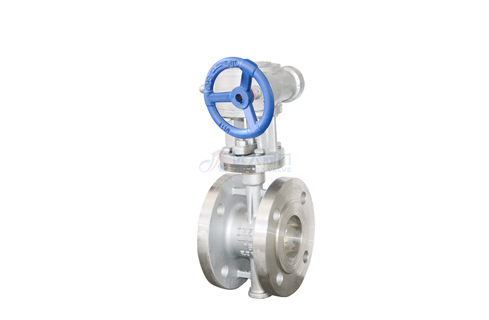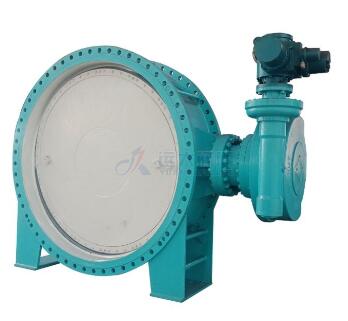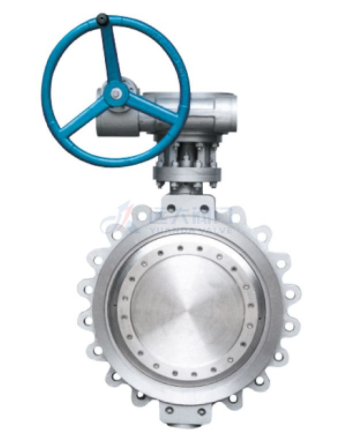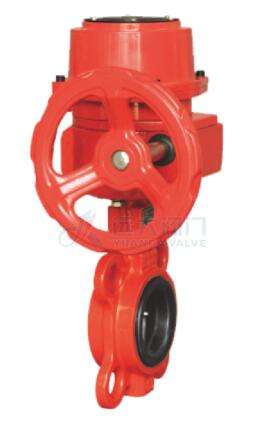The invention of the butterfly valve has improved the processes and applications of various industries.
What is a butterfly valve?
The butterfly valve is a mechanism that regulates the flow of materials in a large pipe diameter through a quarter-turn rotation of the disc.
A rod passes through the center of the disc, and this rod is connected to a drive that controls the movement of the disc. The position of the disc is parallel or perpendicular to the flow of the medium. The butterfly valve is different from other valves because the butterfly plate is always in the fluid, resulting in pressure changes at any position of the valve.
Double eccentric flange butterfly valve
>> Shop for high-quality butterfly valves here
Why is it called a butterfly valve?
Some valves are named after their shapes, such as ball valves, globe valves, needle valves, etc. Other valves are named after their movement and function: gate valve, plug valve, pinch valve, life valve, slide valve, etc. The butterfly control valve is also named for its movement.
The butterfly valve gets its name because its movement is similar to that of wings in flight. The rod is similar to the body of a butterfly, and the disc moves like a butterfly's wings. The movement of a butterfly valve is similar to that when a butterfly descends, its wings move up and down in a 90-degree motion.
What is the purpose of the butterfly valve?
The butterfly valve regulates the flow by starting, decelerating, or stopping the medium. The disc opens and closes with a low torque of 90 degrees, which is suitable for any compatible application. Because of their low cost and lightweight, butterfly valves are generally more popular than other types of valves.
For some processes, extreme temperatures and corrosion are factors that can easily damage the valve seal. Butterfly valves can withstand extreme cold or extreme heat. This means that the integrity of the sealing device is critical for high-risk applications such as energy production and oil processing (because a leak may threaten public safety or the environment).
Where is the butterfly valve located?
There are some standard guidelines for the positioning of butterfly valve components. The butterfly valve needs to have a certain distance from other parts, such as pumps, elbows, and other valves pipe diameter separation is ideal.
Generally, the valve stem of a butterfly valve is installed vertically with the actuator directly above it, but in some cases, the valve stem is installed horizontally. When connected to a pump or check valve, the disc must have a gap to avoid interference with other nearby components.

Butterfly Valve
3 Main Butterfly Valve Types
While these valves all do essentially the same function, there are variations of butterfly valve design to suit different operations. Below are the three main butterfly valve types.
Zero-offset Butterfly Valve
“Concentric” or “rubber seated” are other names for the zero-offset design. Zero offset means there is no offset by the stem of the valve. The valve seals via interference along the disc edge at the stem between the disc and the rubber seat. The rubber seated valve has the lowest pressure rating (up to 250 PSI) and withstands heat up to 400°F. Its rubber seat encases the body to prevent contact with the material which maintains the purity of the media.
High-Performance Double Offset Butterfly Valve
This butterfly valve is referred to as a double offset because the offset is in two places: at the line of the disc seat /body seal, and the bore. Off-center positioning increases the durability of the seal. High-performance valves tolerate pressure up to 1440 PSI and temps up to 1200°F. A cam-action occurs from the stem behind the disc as it rubs against the during rotation at 90° for the first 10 degrees of opening, but also for the 10 degrees of closing.
Triple Offset Butterfly Valve
The best type of butterfly valve for high-pressure systems is the triple offset butterfly valve. Of the three types, the triple offset is the most advanced with lower emissions, and is designed to work with various environments. Its heat tolerance is 1200°F as it can withstand 1,480 PSI of pressure. Like the double offset valve, the triple offset valve consists of two offsets situated in the center, but with a third offset having cam action with right-angled conical sealing. It is frictionless and long-wearing by the metal seal components not making contact until their final point.
Common Butterfly Valve Applications
Cast steel Butterfly valve
Some processes need more tolerant and wear-resistant valves with special features. Below are some common applications that rely on the unique mechanisms of a butterfly control valve.
ㆍFood Processing
Simple design, high durability, and low maintenance are the features needed to regulate fluid flow in any piping system. Certified Food Grade Seat is best for the Food Processing sector, so a White seat is preferred.
While standard resilient seated valves are not 3A-approved, many on the market maintain sanitary connections inside and outside. The body material for the valve can range from epoxy-coated iron to Nylon 11-coated iron to Bronze, 304SS, and 316SS.
ㆍRefineries
The butterfly valve is commonly found in refineries. These would typically use the more “high end” High-Performance valve with Steel Bodies, or the Triple Offset design that is “Fire Safe” and bubble tight. Many applications involving water use the resiliently seated version.
ㆍShut Off Valves
A butterfly valve is often the best choice as a general shut-off valve above 1.5”-148”. Their simple design allows them to take up less space and less weight than other types of valves. These valves provide a tighter seal than a gate of globe valve and are usually bubble-tight. This is most useful when trying to stop the fluid flow as it prevents any fluid from passing through the pipe when closed.
ㆍShip Building
Because of their high durability in saltwater, butterfly valves are commonly used in ships where ABS-approved materials are selected. This type of valve effectively creates a water-tight shutoff in the piping system of a ship to prevent any flow in the pipe. Their small size also allows them to be used in those tight spaces that are common aboard the ship.
They can be used for “jack up” rigs, ballast systems, ship side, and many other applications. Fire Safe approved valves are also necessary for many applications. Additional capabilities are automation and pneumatic function (“closed-loop” pneumatic underwater, electric, and hydraulic).
Be sure to use valves with an ISO-5211 mounting pad and stem. This way it's easier to get a drop-in replacement at any port. Also, be wary of valves that just have an ISO-5211 mounting pad as the stems are often the manufacturer's “special.”
We are butterfly valve suppliers. Please feel free to contact us if you are interested in our products.




没有评论:
发表评论